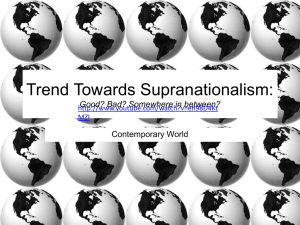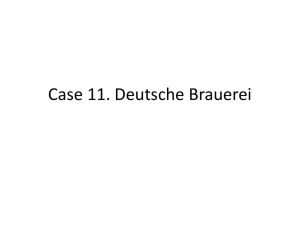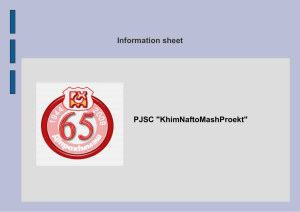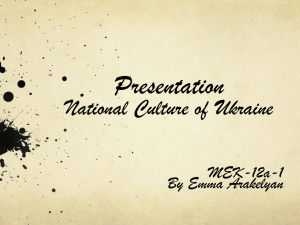Diapositive 1
advertisement
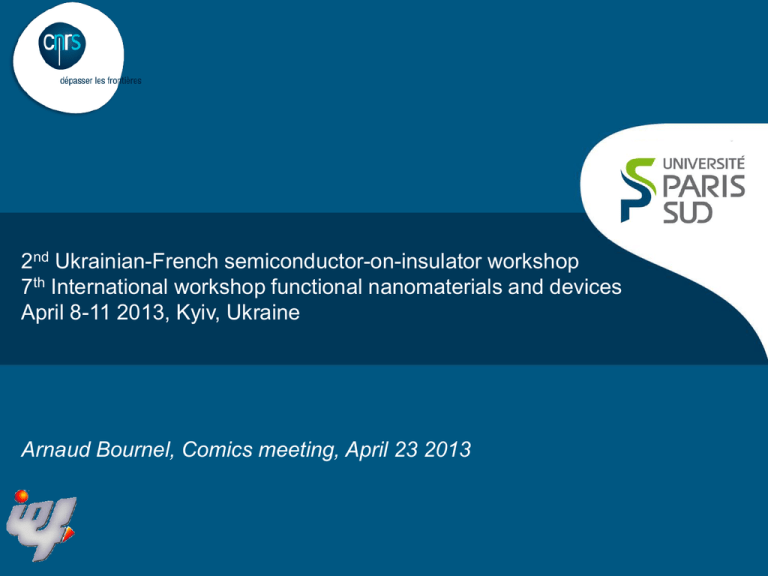
2nd Ukrainian-French semiconductor-on-insulator workshop 7th International workshop functional nanomaterials and devices April 8-11 2013, Kyiv, Ukraine Arnaud Bournel, Comics meeting, April 23 2013 Where? 2 814 258 habitants en 2012 2 / 14 More precisely Cultural center Djerelo 3 / 14 Some pictures… 4 / 14 … with snow 5 / 14 For JS Martin Cathedral St. Michael 6 / 14 Who? Organized by • F. Balestra (IMEP-LAHC Grenoble, France) • D. Flandre (ICTeam, Univ. catholique de Louvain, Belgique) • A. N. Nazarov (Inst. Semicond. Phys., Kiev, Ukraine) 55 participants from 15 countries (Ukraine, Russia, France, Austria, Germany, Ireland, United Kingdom, Belgium, Poland, Brazil…) 7 / 14 What? F. Balestra K. Bourdelle IMEP-LAHC/ Sinano Institute, Grenoble, France SOITEC, Bernin, France C. Fenouillet-Beranger1,2 1) CEA-LETI MINATEC- Grenoble, France et al. 2) STMicroelectronics, Crolles, France V. Kilchytska et al. ICTEAM Institute, UCL, Louvain-laNeuve, Belgium *CEA-Leti, MINATEC Grenoble, France Challenges and solutions for very low energy computation → TFET is great, carbon is bad Engineered substrates for advanced CMOS technology nodes and More-than-Moore applications → XOI for electronics an photonics, smart stackingTM for MEMS & CMOS (3D integration: oxide-oxide, CuCu, through-silicon via or TSV) CMOS performance enhancement with FDSOI technology → ultrathin body and buried oxide: TBOX = 25 nm for 28 nm-node, TSi = 6.5 nm for 14 nm-node) Cf. Grenouillet @IEDM 2012 Ground plane, hybrid integration with bulk… Perspectives of UTBB FD SOI for analog and RF applications → few works on the subject… Effect of self heating, electrostatic coupling with the substrate through the BOX, influence of ground plane, fringe effect du to reduced width fT = 160 GHz & fmax = 140 GHz @ LG = 30 nm. But intrisically fT = 700 GHz Cf. Kilchytska & Makovejev SSE 2012 8 / 14 What? Y.M. Georgieva et al. aTyndall V. Sverdlov, S. Selberherr Institute for Microelectronics, TU Wien, Austria A. Orlikovsky, V. Vyurkov, S. Filippov, I. Semenikhin P.G.D.Agopian 1,2, J.A.Martino 1 et al. National Institute, UCC Cork, Silicon and germanium junctionless nanowire transistors for sensing and Ireland digital electronics applications bTyndall National Institute, Cork, Ireland → Towards autonomous microfluidic sensors: chemical species as cImperial College London, London, UK top gate in the subthreshold regime thanks to a backgate RIE etching for defining NW: low roughness (0.8-1.6 nm, width down to 10 nm) Autonomy? VBG = 0 V if possible…. Silicon spintronics and its applications → A review… As I was young, but Si instead of III-V. Spin relaxation, spin accumulation, spin-FET (still a dream….), single spin readout in a Si SET, Nitrogen-Vacancy centers in diamond? Van de Sar, Nature 484 Institute of Physics and Technology, RAS, Quantum noise in nano-transistors Moscow, Russia → Model of quantum excess noise at finite temperature thanks to Landauer-Buttiker approach, cf. Vyurkov SSE 2012 1LSI/ PSI/USP - University of Sao Paulo, Early voltage and transistor efficiency of pTFET compared to pFinFET triSP, Brazil gate devices 2Centro Universitario da FEI, SBC, Brazil → Fabrication on the same wafer (N+ source instead of P+ source) 3Imec, Leuven, Belgium 10× higher gm/ID, 2× higher Early voltage, +30 dB of voltage gain 4E.E. Dept., KU Leuven, Belgium in TFET But Ion = 0.6 nA vs. 1.1 mA 9 / 14 What? C. Teichert Institute of Physics, Leoben, Austria M. Phaner Université de Lyon, Ecully, France 1Lashkaryov ISP, NASU, Kiev, Ukraine T. Rudenko1 A. Nazarov1, .R. Yu2, 2Tyndall National Institute, UCC Cork, Ireland S. Barraud3 et al. 3CEA-LETI, MINATEC, Grenoble, France V.P. Popov, I.E. Tyschenko, *A.N. Nazarov, **T.S. Ávila, **P.L. Grande Rzhanov ISP, SB RAS, Novosibirsk, Russia *Lashkaryov ISP, NASU, Kiev, Ukraine **Institute of Physics, UFRGS, Porto Alegre, Brazil Atomic-force microscopy based diagnostics of functional nanomaterials → A good review, no device Growth of Pentacene thin films for Organic Field Effect Transistors: an AFM study → Influence of thickness on the organization of the pentacene grains/islands 30 nm: the best. Then decrease of mobility due to access resistance (conduction in the first layers) On mobility behavior in high doped junctionless nanowire MOSFETs → Doping larger than 1019 cm-3 Better gate control leads to higher electron density, then to stronger screening of doped impurities and finally to a (slightly) higher mobility…. Carrier transport in few nanometer SOI layers with Ge atoms incorporated from BOX → 2 nm-thick SiGeOI: Ge implantation in SiO2, Si bonded on top, H+ mplant for smart cut, annealing… 2-3× higher hole mobility Benefice / Ge condensation? Ultrathin films… 10 / 26 What? P.K. Hurley1, É. O’Connor1, V. Djara1, J. Lin1, S. Monaghan1, I. Povey1, M. Pemble1, Y.Y. Gomeniuk2, K. Cherkaoui1 L.Khomenkova1,2, X. Portier1, A. Slaoui3, F. Gourbilleau1 1Tyndall Y.Y. Gomeniuk1, et al. 1Lashkaryov National Institute, UCC Cork, Ireland 2Lashkaryov ISP, NASU, Kiev, Ukraine Investigating the electronic properties of the high-k/InGaAs MOS system 1CIMAP, Caen Cedex 4, France Charge trapping in hafnium silicate films with modulated ISP, NASU, Kyiv, Ukraine composition and enhanced permittivity 3InESS, ULP/CNRS, Strasbourg, France 2Lashkaryov ISP, NASU, Kyiv, Ukraine Conduction-band offsets in Pd/Al2O3/InGaAs MOS structure National Institute, UCC Cork, Ireland 2Tyndall 11 / 14 What? 1University of Siegen, Germany Royal Institute of Technology, Kista, Sweden The potential of graphene devices for More than Moore applications → Hot electron vertical transistor, with Al2O3 and SiO2 insulators betwwen emitter and base or base and collector: Mehr IEEE EDL 2012, Vaziri SSE 2013 & NanoLett 2013. THz feasible in theory… Bandstructure changes induced by strain for piezoresistive sensors (collab with Palestri) M.V. Strikha Lashkaryov ISP, NASU, Kyiv, Ukraine Non-volatile memory of new generation and ultrafast IR modulators based on graphene on ferroelectric substrate A.N. Nazarov1 et al. 1Lashkaryov M. Lemme1,2 2KTH 2Rzhanov ISP, NASU, Kyiv, Ukraine Graphene layers fabricated from Ni/carbon-rich a-SiC bilayer ISP, SB RAS, Novosibirsk, precursor Russia D. Svintsov1, V. Vyurkov1, A. Orlikovsky1, V. Ryzhii2, T. Otsuji2 1Institute of Physics and Technology, All-graphene tunnel field-effect transistor RAS, Moscow, Russia → Schottky source-drain, cf. Sze 1968 2RIEC, Tohoku University, Sendai, Japan 12 / 14 What? D. Flandre ICTEAM Institute, UCL, Louvain- Nanopower sensing with nanoelectronics la-Neuve, Belgium IMEP-LAHC Minatec, CNRSG. Ardila, A. Kaminski-Cachopo, Grenoble INP, UJF, France M. Pala, A. Cresti, L. Montès, R. Hinchet, J. Michallon, M. Daanoune, M. Mouis University of Liverpool, UK S. Hall, N. Sedghi, I.Z. Mitrovic, J.F. Ralph, Y. Huang A.G. Ulyashin Towards self-powered systems: using nanostructures to harvest ambient energy Solar energy harvesting using THz electronics SINTEF Material and Chemistry, Nanostructures and nanotechnologies for Si based photovoltaics Oslo, Norway 13 / 14 My talk Non linear effect in graphene devices A. Bournel, V. Hung Nguyen, A. Alarcon, S. Berrada, D. Van Nam, J. Saint Martin, D. Querlioz, P. Dollfus • Transport properties in graphene and GFET (pseudo saturation…) • Resonant and non linear effects in graphene bilayer • Esaki-like PN tunnel diodes based on graphene monolayer 14 / 14

